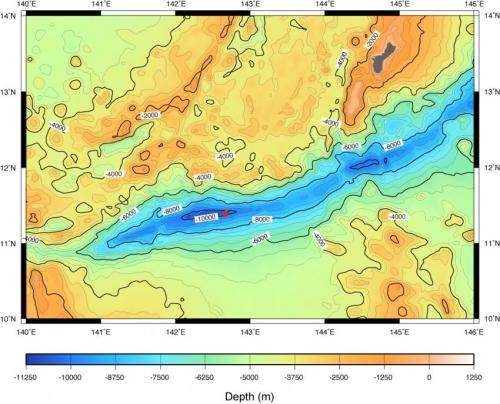February 26, 2015 weblog
Remotely operated vehicle finds heterotrophs abundant in deepest part of the ocean

A team of researchers with ties to several institutions in Japan has found an abundance of microscopic bacteria known as heterotrophs living on or near the ocean floor in the deepest part of the Mariana Trench. In their paper published in Proceedings of the National Academy of Sciences, the team describes their expedition work and what they found using a remotely operated vehicle (ROV).
The Mariana Trench is located in the western Pacific Ocean, some distance east of Taiwan. One part of it known as Challenger Deep, is the deepest, and holds the record for the deepest part of the ocean. Scientists are eager to learn more about what sort of life forms can live there, approximately 36,000 feet below the surface, both for curiosity's sake and because what they learn may help with the search for life on other planets. In this new effort, the researchers took a closer look than those before them, sifting the waters below looking for creatures too small to be spotted with cameras. They sent their ROV down with an ability to not just note microscopic sized life forms, but to count how many were seen.
Near the surface, where sunlight can penetrate, the team found an abundance of plantlike phytoplankton. Below that is known as the abyssal zone, because of the lack of nutrients available—there is very little life, it is mostly made up of tiny chemolithotrophs which can convert compounds such as ammonia or sulfur into food. Much farther down there is little in the way of observable life, but a closer look revealed that the abundance of tiny organisms increased again as food was more plentiful near the bottom. Heterotrophs cannot fix carbon and thus must use organic carbon to survive in the extremely cold and dark environment. It appears, the team reports, that they live on fecal matter or other dust particles that fall down from above. They also note that infrequent landslides in the area can release food that has been trapped, providing food for years at a time. For comparison purposes, the researchers pointed out that the number of microbes in the water was comparable to untreated well water. The researchers also measured salinity, temperature and chemistry at various depths. They were able to differentiate between different microbes using genetic testing.
via LiveScience
More information: PNAS DOI: 10.1073/pnas.1421816112
Journal information: Proceedings of the National Academy of Sciences
© 2015 Phys.org



















